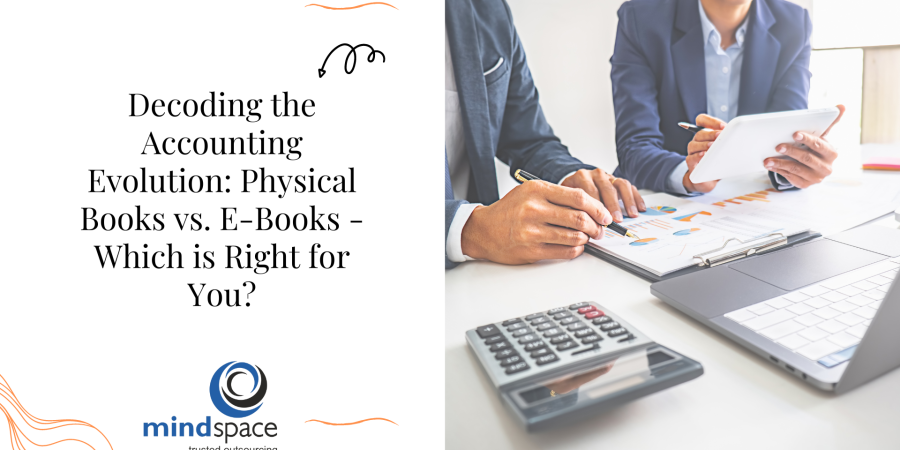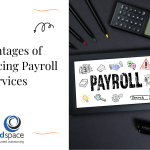Decoding the Accounting Evolution: Physical Books vs. E-Books – Which is Right for You?
- INTRODUCTION-
The evolution of accounting practices has been greatly influenced by advancements in technology, particularly in the realm of bookkeeping and record-keeping methods. Traditional physical accounting books, with their tangible presence and time-tested reliability, have long been the cornerstone of accounting practices. However, the rise of digitalization has introduced a new player into the field: electronic accounting books, or e-books. Physical accounting books have served as trusted companions to accountants for generations. Their tangible nature provides a sense of permanence and security, allowing accountants to meticulously record financial transactions, ledger entries, and other pertinent data with pen and paper. The tactile experience of flipping through pages, annotating entries, and cross-referencing information has been a hallmark of traditional accounting methods. In contrast, e-books offer a modern alternative to physical accounting books, leveraging digital technology to streamline accounting processes and enhance accessibility. With e-books, accountants can easily search for specific entries, create digital bookmarks, and generate reports with just a few clicks. The debate between physical accounting books and e-books encompasses various considerations, including cost, accessibility, environmental impact, and customization options. In this blog, we will explore the differences between physical accounting books and e-books, examining their respective advantages, disadvantages, and practical implications for accounting professionals. By delving into these topics, we aim to provide insights into the evolving landscape of accounting practices and help professionals make informed decisions about the most suitable bookkeeping methods for their needs.
- COST CONSIDERATIONS-
Cost considerations play a significant role in the decision-making process when choosing between physical accounting books and e-books.
- Initial Purchase Cost:
- Physical Accounting Books: The initial cost of purchasing physical accounting books includes the price of the books themselves, along with any additional supplies such as ledger paper, binders, or dividers. Depending on the quality and quantity of the books required, this initial investment can vary.
- E-Books: E-books typically involve an upfront cost for purchasing accounting software or subscriptions to digital platforms that offer e-book functionalities. While some e-books may be available for free or at a lower cost, premium e-book solutions may require a more substantial initial investment.
- Long-Term Savings:
- Physical Accounting Books: While physical accounting books may incur lower upfront costs compared to e-books, they may result in higher long-term expenses due to maintenance, storage, and replacement costs. Over time, the cumulative expenses associated with physical books may outweigh the initial savings.
- E-Books: Despite the higher initial investment, e-books can offer long-term savings potential. Once the initial setup is complete, e-books require minimal ongoing expenses, resulting in potential cost savings over time. Additionally, e-books may offer features such as automation and integration with other accounting tools, further enhancing efficiency and cost-effectiveness.
- ENVIRONMENTAL IMPACT-
The environmental impact is a crucial consideration when comparing physical accounting books to e-books.
- Waste Generation:
- Physical Accounting Books: Physical accounting books generate waste throughout their lifecycle, from the production of paper and ink to eventual disposal. As books become obsolete or damaged, they may end up in landfills, contributing to solid waste accumulation and environmental pollution.
- E-Books: E-books produce minimal waste since they are stored digitally and do not require physical materials like paper or ink. The electronic storage of accounting data reduces the generation of paper waste and contributes to waste reduction efforts.
- Sustainability Practices:
- E-Books: Many e-book platforms and accounting software providers prioritize sustainability by implementing eco-friendly practices such as using renewable energy sources, minimizing energy consumption, and promoting digital initiatives. By choosing e-books, businesses can align with sustainability goals and reduce their environmental impact.
- Physical Accounting Books: While efforts can be made to source paper from sustainably managed forests and implement recycling programs, physical accounting books inherently have a more significant environmental footprint compared to e-books.
- CUSTOMIZATION AND INTERACTIVITY-
Customization and interactivity are essential aspects to consider when comparing physical accounting books to e-books.
- Physical Accounting Books:
- Customization: Physical accounting books offer limited customization options compared to e-books. However, users can personalize their books by adding annotations, sticky notes, and bookmarks to highlight important information or make relevant comments. Customization options are typically limited to manual additions and modifications made directly on the pages of the book.
- Interactivity: Interactivity in physical accounting books is minimal. While users can manually flip through pages, add notes, or cross-reference information, the level of interactivity is limited compared to e-books. Physical books do not offer interactive features such as clickable links, multimedia content, or real-time updates.
- Benefits of Customization and Interactivity:
- Efficiency: Customization allows users to tailor accounting resources and reports to their specific needs, streamlining workflows and increasing efficiency. Interactivity enhances user engagement and comprehension, making it easier to access, analyse, and interpret financial data.
- Flexibility: Customization and interactivity provide flexibility for users to adapt accounting materials and processes to changing requirements or preferences. Users can customize reports, templates, and dashboards to meet evolving business needs and regulatory requirements.
- CONCLUSION-
In conclusion, the comparison between physical accounting books and e-books highlights the significant advantages offered by e-books in terms of customization and interactivity. While physical accounting books offer some degree of customization through manual annotations and personalization, their capabilities are limited compared to the extensive customization options available with e-books. E-books empower users to tailor the appearance, layout, and content of accounting materials to their specific preferences and requirements, enhancing usability and efficiency. Furthermore, e-books provide a high level of interactivity, enabling users to engage with accounting content in dynamic and interactive ways. From clickable links and multimedia content to real-time collaboration tools and advanced search functionality, e-books offer a range of interactive features that facilitate user engagement, comprehension, and productivity. The benefits of customization and interactivity offered by e-books extend beyond individual users to impact organizational efficiency, flexibility, and collaboration. Customizable templates, reports, and dashboards ensure consistency and standardization across accounting processes, while also accommodating individual preferences and needs. Interactive features foster collaboration among accounting professionals, enabling real-time sharing, editing, and collaboration on accounting documents and projects. Overall, e-books represent a modern and versatile solution for accounting practices, providing users with the flexibility, efficiency, and collaboration capabilities needed to meet the demands of today’s dynamic business environment. By embracing e-books, businesses and accounting professionals can optimize their workflows, enhance productivity, and drive better decision-making in managing accounting processes and resources.


